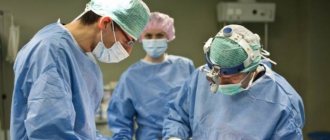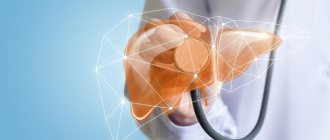Often, methods of examining internal organs bring unpleasant sensations to a person, which is why many patients try to avoid going to the hospital for as long as possible. CT scan of the intestines is a safe, painless method of virtual diagnosis of the disease, which, using a tomograph, provides detailed information about the condition of the intestines and rectum.
- 9.1 Which is better for bowel examination, CT or MRI?
Contraindications
If a person is heavy, he may not fit into the camera of a standard tomograph. For such people, a special tomograph is offered that takes into account volumes and weight.
If the patient has an active phase of Crohn's disease, an exacerbation of the ulcer, or inflammatory processes in the intestines, then in such cases the procedure is not recommended, but rather wait until the symptoms subside.
If at the time of the study the patient is not feeling well, he is experiencing pain and discomfort, then intestinal tomography is not recommended.
Computed virtual tomography of an organ is only a diagnostic procedure, therefore, if there are polyps or other neoplasms, they are removed using a separate surgical intervention.
What does a CT scan of the stomach show?
It should be noted that based on the patient’s complaints, the study can be performed in a comprehensive manner: CT of the esophagus and stomach, CT of the stomach and intestines, because all these departments form a single gastrointestinal tract.
When performing a scan of the gastrointestinal tract, the radiologist can see the following:
- The structure of the gastrointestinal tract.
- Existing foreign bodies.
- Abdominal abscess.
- Tumor process, metastases, cysts of the gastrointestinal tract.
- Traumatic damage to organs: stomach, esophagus, intestines.
- Identification of structural features in patients before and after treatment, as well as after surgery.
- The work of the circulatory system of these organs.
Preparation
In order for the CT results to be as informative as possible, it is necessary to carefully prepare for this procedure.
Preparatory diet
3 days before diagnosis, you must completely remove from your diet all foods that:
- cause digestive problems;
- have an irritating effect on the gastrointestinal tract;
- cause constipation or diarrhea, bloating, colic.
These include:
- fried and fatty dishes with spicy dressings;
- sweets with oil fillings;
- baked goods, fresh white bread;
- carbonated drinks, strong tea and coffee;
- vegetables and fruits that can irritate the mucous membranes.
Purgation
During the diet, it is recommended to take activated carbon tablets or other sorbents. In the evening, before the virtual CT procedure itself, it is necessary to cleanse the intestines using an enema with a special solution, or other laxatives that are easy to use.
You can use a medicine such as Duphalac. It has a mild cleansing effect and contains a safe substance, fructose. The drug gently relaxes the intestinal walls, helping to get rid of feces painlessly.
On the day the procedure is to take place, you are prohibited from eating or drinking any liquid. When performing a tomography, you should remove all objects that contain metal.
What diseases require computed tomography to diagnose?
As a rule, CT is necessary for stomach cancer, as well as other types of oncological processes in this organ. The insidiousness of malignant neoplasms lies in the fact that they are capable of affecting not only the organ in which the tumor began to grow, but also germinating into neighboring tissues and organs, as well as giving distant metastases (to the liver, lungs, brain), these complications are not visible when gastroscopy. Regional (neighboring) lymph nodes are also affected by cancer.
CT scan allows not only to detect the extent of the neoplasm within the wall of the organ, but also the extent of the spread of the process in the abdominal cavity and lymph nodes. Another advantage of CT over gastroscopy is that having identified a pathology in the stomach, the doctor can immediately examine neighboring organs: the pancreas, liver, peritoneum.
In case of cancer, such information is necessary so that the oncologist can determine the method of treatment for the patient; for example, in the initial stages of the oncological process, radical surgery is necessary to remove the tumor. For cancer that has spread beyond the stomach, surgery is contraindicated, as it can accelerate tumor growth, so chemotherapy and radiation therapy are necessary.
CT is informative not only for the diagnosis of malignant neoplasms, just like gastroscopy, it shows benign tumors, polyps, strictures and stenoses. The method is rarely used to diagnose peptic ulcer disease, since filling the organ with liquid or gas can cause complications: perforation or bleeding from the ulcer, so diagnosis is carried out mainly using gastroscopy.
Technique
The patient is placed on a special diagnostic table in a lying position, but it happens that it becomes necessary to place the person on his side or stomach. To avoid unnecessary movements, it is possible to use a special belt.
Next, a small tube is used, which is inserted 4-6 cm into the anus to fill the rectum with air. This is necessary to straighten folds, wrinkles and other deformations in which neoplasms, polyps, cracks and ulcers may be localized.
A CT scan of the intestines can last 15-20 minutes.
Next, the table with the patient begins to move deeper into the scanner. The patient will be asked to hold the air for 20 seconds before turning over. The sequence of placement during scanning varies among institutions. In a tomography scanner, a person sees bright rays of light that are projected onto his body. This is necessary to determine the correct positioning of the patient's body. When the machine begins to operate, the patient may hear a quiet buzzing or humming sound.
The patient must be alone in the room for the study, but in certain situations, if, for example, a child is being scanned, then relatives are nearby.
A CT scan of the intestine lasts no more than 20 minutes. In the next room, a computer monitor shows images, which are then superimposed on each other, which makes it possible to see a 3-D image and determine the presence of pathology.
After diagnosis, a person experiences bloating and flatulence, but this uncomfortable condition quickly passes. If you have been injected with a special substance, then it is not advisable to drive; you need to wait until its effect wears off. When breastfeeding, it is necessary to milk and empty the milk for several days, as it is not suitable for feeding.
How is a CT scan of the stomach done?
Half an hour before the examination, the patient drinks 1 liter of still water; immediately before scanning, a mixture of water, soda and citric acid. After the preparatory stage, the patient is transferred to the room where the tomograph is located and placed on a special support table of the device. During the examination, the patient is in a position on the left side, the patient is fixed to maintain a motionless position. The patient is left alone in the room, and the doctor who is conducting the study watches him from the next office through the window, maintaining communication through a loudspeaker.
Examination with contrast
Contrast diagnostics of the intestine is necessary to obtain improved image quality. To do this, the patient is asked to drink a composition with a barium suspension within 2 days in order to obtain a contrast. You can give an injection of this substance, but in this case you will need to discontinue certain medications. The preparation process for contrast-enhanced tomography is the same as for conventional tomography. The patient is prohibited from eating or drinking on the day of the procedure.
Contrast examination of the intestine has a number of contraindications, namely:
- allergic reaction to seafood and iodine;
- diabetes;
- asthma;
- diseases of the cardiovascular system, liver, kidneys;
- During pregnancy and breastfeeding;
- small children - up to 12 years old.
Virtual CT scan of the intestine with contrast is not performed on patients weighing more than 200 kg, since such a weight does not allow for adequate diagnosis; in this case, the doctor may suggest an alternative method.
When performing a computed tomography scan with contrast, it is necessary to ensure the normal functioning of the liver and kidneys, since the contrast agent can accumulate in them, which affects the functioning of the organs. You also need to have the results of a biochemical test of blood and urine with you.
Where to get a CT scan of the stomach in St. Petersburg and Moscow?
You can choose the location of this examination in the city and region yourself, based on your personal preferences for the cost of the procedure, the location of the clinic, as well as the characteristics of the tomograph itself: the level of radiation exposure, the possible slice thickness for MSCT, with or without contrast. The ideal tomographs are those where the stepwise cutting capability is , or better yet , . The level of radiation exposure in modern tomographs does not exceed the permissible level. It is worth noting that some diagnostic centers in the city operate in the evening and at night, which is important for working patients who do not have the opportunity to undergo examination during the day, and this factor is also taken into account when choosing a place for testing.
Alternative Methods
Sometimes it happens that for one reason or another, spiral computed tomography is contraindicated for a patient. In this case, you can use alternative methods that are no less informative:
- virtual colonoscopy;
- diagnostics using magnetic resonance imaging;
- ultrasound examination;
- positron emission tomography;
- capsule endoscopy.
In any case, the doctor will recommend the safest and most informative examination method, taking into account the patient’s condition and well-being.
Which is better for bowel examination, CT or MRI?
If there is a need to obtain accurate data that will help assess the situation as much as possible, then spiral computed tomography will definitely be preferable to the magnetic resonance imaging method. These two diagnostic methods are similar to each other, however, when it comes to examining the intestines, the second method will provide less data.
In computed tomography, the examination is carried out using x-rays. With magnetic resonance imaging, the patient is exposed to a powerful magnetic field, which changes the position of hydrogen atoms in the body. This is the significant difference between these two diagnostic methods.
Which is better: CT scan or colonoscopy?
In this case, the choice of doctor depends on the condition in which the patient is at the time of the examination. In certain situations, there is a need for a CT scan, and sometimes a colonoscopy is preferred, when, for example, a biopsy is required.
Colonoscopy itself is an unpleasant procedure that often causes discomfort and pain to the patient, as it involves inserting a tube with an endoscope into the rectum. However, if there is a suspicion of the presence of a neoplasm, regardless of its benign or malignant nature, the CT method will be more preferable.
During pregnancy, computed tomography of the intestines is contraindicated, since the study produces x-rays that can negatively affect the development of the fetus, so if there is a need for diagnosis, then in this case a colonoscopy would be preferable.
In other cases, the doctor weighs all the risks and directs the patient to the diagnostic method that is more necessary at a specific period in the development of the disease.
In what cases is CT diagnostics of the large intestine prescribed?
Computed tomography of the colon is an alternative examination method. It is prescribed if the patient flatly refuses a colonoscopy, and MRI is contraindicated for him (for example, the presence of a pacemaker). Most often, on a CT scan, the large intestine is examined in conjunction with the abdominal organs. Without the use of contrast, the procedure takes about 20 minutes. A special tube is inserted into the patient's anus, through which air is supplied to the large intestine. This is necessary to level the intestinal walls, since the layering of this organ impairs visualization. The procedure is completely painless, with only the slightest discomfort for the patient - bloating.











